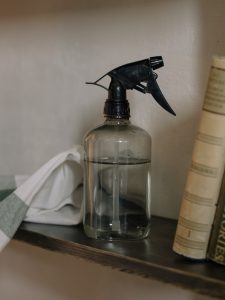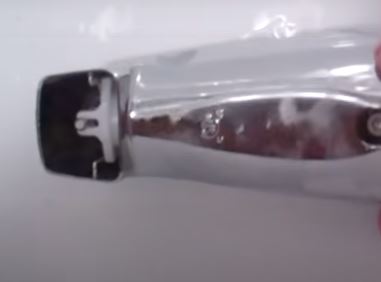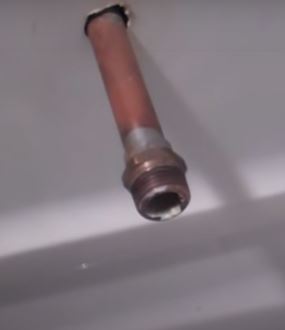Why is My Bathtub/Shower Diverter Stuck?
If you use a bathtub-shower-combo then you definitely have a shower diverter on your bathtub spout. It is a fantastic design that allows you to have a bathtub as a shower cubicle especially for people with small bathrooms.
A shower diverter is a small knob on top of the bathtub spout that regulates the flow of water. When the knob is pulled up, water flows out from the showerhead. If you want water to flow out from the bathtub spout simply push the diverter knob down.
After years of usage, your shower diverter may get stuck in one position. This means that you no longer have the option to either user the showerhead or the bathtub. What causes this though?
A stuck shower diverter is caused by debris, pipe corrosions and accumulation of mineral deposits in the bathtub spout. The substances embed on the groove inside the spout thereby restricting the free up and down movement of the diverter causing it jam.
People who live in areas with hard water, old houses with steel pipes and those who use water from a well are more susceptible to this problem. Luckily, a stuck shower diverter can be easily fixed and doesn’t always need to be replaced.
Soaking the bathtub spout in a vinegar solution or spraying it with a penetrating oil are 2 great ways to free a stuck shower diverter. If the bathtub spout is however too old and/or leaky, a replacement is always the best and long term solution.
Sometimes instead of having a sticky shower diverter, you will notice that it won’t stay up. A shower diverter that won’t stay up is caused by low water pressure in the line or a defective bathtub spout. Attach a pressure gauge to a spigot to determine house the pressure. If the pressure is ok replace the spout.
How to Fix a Stuck Shower Diverter
There are several ways to fix a stuck shower diverter. The choice depends on the severity of problems and to some extent the materials available. The good things is that all the materials needed for this job are readily available in most homes.
1. Use a Penetrating Oil

A penetrating oil like WD-40 works magic in loosen tight connections as well as preventing rust and that’s why you will never miss it in any garage. In case you did not know, the WD in WD-40 stands for water displacement.
In order for rust to take place, water and oxygen have to be present on an iron surface. By displacing water, WD-40 prevents surfaces from corroding. WD-40 is however not the only penetrating oil you can use. Any penetrating oil will work just fine, including a non-stick cooking oil.
Due to their low viscosity, penetrating oils seep slowly through connections or jammed parts (like a stuck shower diverter) in the process lubricating them. Dash to the garage and grab a can of your favorite lubricating oil.
Here is how to lubricate a stuck shower diverter:
- Dry the water first. If there is water inside or on top of the spout, use a rag or towel to dry it completely. As you already know, oil and water are not the best of friends.
- Spray the penetrating oil directly on the shower diverter knob at the top of the bathtub spout.
- Insert the straw of the oil can inside the tub spout and spray the inside as well.
- Pull and push the knob up and down as you spray more oil. If the knob is too stuck you might want to wait for about 15 to 30 minutes.
- Try to pull and push the shower diverter up and down after the 30 minutes.
- If it feels less resistant than earlier, spray more penetrating oil and wait for another 15 minutes.
- Keep spraying the penetrating oil and playing with the knob until it loosens up completely.
2. Soak the Shower Diverter in Vinegar
For folks who live in areas with hard water, I expect the cause of the stuck shower diverter to be calcium build up. Lime, which is basically calcium is the whitish substance that you might also notice at the bottom of the bathtub after draining it.
After many years of usage, calcium builds up inside the spout, restricting the movement of the shower diverter. If this is the problem, it will also affect your shower head and you will notice that there is low water pressure coming out of your showerhead.
Vinegar is a mild acid which is fantastic cleaning agent on its own as well as when combined with baking soda. It dissolves calcium deposits in faucets quite effectively and will definitely loosen a stuck shower diverter.
This is how to proceed:
- Look for a small (preferably clear) plastic bag.
- Fill it with vinegar all the way to the ½ or ¾ mark.
- Bring the vinegar with you inside the bathtub and push the spout inside the vinegar so that most it (and especially the shower diverter knob) is immersed in the vinegar. Secure the plastic bag to the spout using a rubber band.
- Leave the solution in place for 12 hours or preferably overnight.
- After the 12 hours remove the vinegar and try to pull and push the shower diverter knob. I can almost guarantee you that it will be way easier this time round.
- Blast hot water through the spout to remove all the loosely attached calcium deposits.
3. File the Shower Diverter Groove

You will need a bit of flexibility to do this, especially if you have no idea how the inside of a bathtub spout looks like. It’s however not rocket science and you will be able to do it in 10 minutes.
A shower diverter acts like a gate inside the bathtub spout. There are 2 grooves inside the bathtub spout where the shower diverter is fitted allowing it to move up and down. A nylon piece is the one responsible for blocking the spout and hence divert water to the showerhead.
When you notice that your shower diverter is sticky, it could be that the groove is corroded. Although most of these faucets look as if they are made of brass, the truth of the matter is that they are just iron/steel coated to look like brass hence they will rust/corrode.
To fix this problem look for a small file that can fit inside the bathtub spout. The file should have teeth on the edges as well. You will be using the edge of the file and not the flat side. Here is how to go about it.
- Pull the shower diverter knob up. This could be hard but just force it up. This will allow you to access the 2 grooves from the bathtub spout opening.
- Slide the file inside one of the groove and start filing it up and down. Don’t be too aggressive as you do not want to file the body of the spout. You just need to remove the rust and mineral deposits.
- When you are satisfied that the groove is clean move to the next one and file it as well.
- Push the shower diverter knob down and pull it up again. You will notice that this time round it is moving up and done freely.
4. Soak the Whole Bathtub Spout in Vinegar

Sometimes the best wat to fix a sticky shower diverter is to soak the whole assembly in a bowl of vinegar. This is a far better solution that tying a plastic bag around it as the vinegar will reach and act on every part of the spout.
There are 2 common types of bathtub spouts. One which is usually threaded to the water supply pipe and another which is usually connected to the pipe using an Allen screw. Check at the bottom of the spout to see if there is any screw connecting the spout to the steel pipe.
Proceed as follows:
- Grab a set of Allen wrenches and use the correct size to loosen the screw. You actually don’t need to remove the screw completely. Just loosen it and slide the spout out. To be safe, plug off the bathtub drain so as not lose the screw down the drain.
- If there is no screw under the spout, the spout is threaded to the supply pipe. Often, this type of spout will also be caulked to the bathroom wall. Use a knife to cut the caulk.
- Wrap a rag or duct tape around the spout (so as not to scratch it) and loosen it with an adjustable wrench by turning it counterclockwise.
- Once the spout is out, put it inside a bowl and add vinegar until evert part of the spout is immersed in the vinegar.
- Let the spout sit in the vinegar for 12 hours or overnight.
- While you wait for the spout to get all cleaned up, use a toothbrush or any other drain brush to clean inside the supply pipe where the spout was connected to. Open the water and flush the line for a few seconds.
- After the 12 hours, clean every part of the spout with a brush or emery cloth so that the shower diverter starts working like a new one.
- Connect the bathtub spout back to the steel pipe. Caulk it in place if necessary.
5. Replace the Bathtub Spout
If your current bathtub spout and shower diverter are in a quite bad shape and therefore not worth fixing, the best and long term approach is to replace them. By so doing you will have peace of mind for the next 10 years or more.
There are 2 things that you really need to be careful about while buying a new bathtub faucet. These are:
- The type of spout – Buy a bathtub spout that looks like your old spout in design. If the old one was threaded it means the supply pipe is threaded too so you should buy one which is threaded too. The same case applies for spouts that use an Allen screw to secure them.
- The length of the supply pipe. Measure the length of the supply line from the wall to the end. Note the measurement down and use it to buy a new spout. You don’t want to buy a longer spout or smaller which will leave the supply line exposed.
Once you have the new spout go ahead and install. Here is how to install a bathtub spout

- If the supply pipe is threaded, use a wire brush or toothbrush to clean it, removing the old tape off it.
- Apply a new layer of Teflon tape on the threads and thread the spout on the pipe. Tighten it with a wrench. You have to be careful so that you get the right tension on the spout without damaging it, and also ensure that the spout orientation is right.
- If you have a spout with an Allen screw just slide it in the pipe and screw it in place.
- Put the new shower diverter to the test.
Abd that is how to fix a stuck shower diverter. I am sure one of this 5 ideas will work perfectly for you.



![How to fix error 0xc000000e windows 10 2022 100 SOLVED 11 How to fix error 0xc000000e windows 10 2022: [100% SOLVED]](https://dreamcheeky.com/wp-content/uploads/2022/06/How-to-fix-error-0xc000000e-windows-10-2022-100-SOLVED.jpg)
![how to fix Error code 0xc0000001 2022 100 FIXED 12 how to fix Error code 0xc0000001 2022 :[100% FIXED]](https://dreamcheeky.com/wp-content/uploads/2022/06/how-to-fix-Error-code-0xc0000001-2022-100-FIXED.jpg)